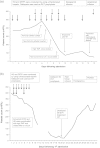Management of heparin-induced thrombocytopenia (HIT) in patients with systemic vasculitis and pulmonary haemorrhage
- PMID: 26069831
- PMCID: PMC4438357
- DOI: 10.1093/ckj/sft075
Management of heparin-induced thrombocytopenia (HIT) in patients with systemic vasculitis and pulmonary haemorrhage
Abstract
Heparin-induced thrombocytopenia (HIT) is a relatively uncommon but potentially fatal complication of the use of heparin in haemodialysis. It is associated with a risk of venous and arterial thrombosis due to the formation of a heparin-platelet factor 4 antibody. Early recognition and immediate treatment of HIT are crucial to reduce the morbidity and mortality rate. Here, we report two patients with acute kidney injury due to anti-glomerular membrane (GBM) glomerulonephritis and granulomatosis with polyangiitis respectively who developed haemoptysis and pulmonary haemorrhage complicated by HIT. We discuss the diagnostic and management challenges of such patients.
Keywords: anti-glomerular membrane (GBM) glomerulonephritis; granulomatosis with polyangiitis; heparin-induced thrombocytopenia (HIT); thrombosis.
Figures
Similar articles
-
Heparin-induced thrombocytopenia: an uncommon but serious complication of heparin use in renal replacement therapy.Hemodial Int. 2006 Jul;10(3):235-40. doi: 10.1111/j.1542-4758.2006.00101.x. Hemodial Int. 2006. PMID: 16805883
-
Management of Saddle Pulmonary Embolism in the Context of Heparin-Induced Thrombocytopenia and Granulomatosis With Polyangiitis.Cureus. 2024 Oct 22;16(10):e72096. doi: 10.7759/cureus.72096. eCollection 2024 Oct. Cureus. 2024. PMID: 39575034 Free PMC article.
-
Heparin-induced thrombocytopenia: a common complication in cardiac transplant recipients.J Heart Lung Transplant. 2002 Dec;21(12):1283-9. doi: 10.1016/s1053-2498(02)00458-8. J Heart Lung Transplant. 2002. PMID: 12490273
-
The approach to heparin-induced thrombocytopenia.Semin Respir Crit Care Med. 2008 Feb;29(1):66-74. doi: 10.1055/s-2008-1047564. Semin Respir Crit Care Med. 2008. PMID: 18302088 Review.
-
Clinical presentation of heparin-induced thrombocytopenia.Semin Hematol. 1998 Oct;35(4 Suppl 5):9-16; discussion 35-6. Semin Hematol. 1998. PMID: 9855179 Review.
Cited by
-
Case Report: Anti-platelet factor 4 -mediated immunothrombosis in a patient with ANCA vasculitis - a shared mechanism of NETosis.Front Immunol. 2025 Apr 10;16:1567999. doi: 10.3389/fimmu.2025.1567999. eCollection 2025. Front Immunol. 2025. PMID: 40276517 Free PMC article.
-
Anti-neutrophil cytoplasmic antibody-associated vasculitis accompanied by type II heparin-induced thrombocytopenia resulting in asymptomatic cerebral infarction: a case report.BMC Nephrol. 2021 Jun 14;22(1):220. doi: 10.1186/s12882-021-02433-8. BMC Nephrol. 2021. PMID: 34126959 Free PMC article.
-
Different Types of Vasculitis Complicated by Heparin-Induced Thrombocytopenia-Analysis of Four Cases and Literature Review.J Clin Med. 2023 Sep 24;12(19):6176. doi: 10.3390/jcm12196176. J Clin Med. 2023. PMID: 37834820 Free PMC article. Review.
-
The Complexity of Pulmonary Complications in Acute Kidney Injury.Curr Health Sci J. 2017 Jan-Mar;43(1):69-72. doi: 10.12865/CHSJ.43.01.10. Epub 2017 Sep 27. Curr Health Sci J. 2017. PMID: 30595857 Free PMC article.
-
A Case of Heparin-Induced Thrombocytopenia That Developed in the Therapeutic Course of Anti-Neutrophil Cytoplasmic Antibody-Associated Vasculitis.Case Rep Rheumatol. 2019 Jul 22;2019:2724304. doi: 10.1155/2019/2724304. eCollection 2019. Case Rep Rheumatol. 2019. PMID: 31428502 Free PMC article.
References
-
- Weismann RE, Tobin RW. Arterial embolism occurring during systemic heparin therapy. AMA Arch Surg. 1958;76:219–225. discussion 225.–217 doi:10.1001/archsurg.1958.01280200041005. - DOI - PubMed
-
- Hutchison CA, Dasgupta I. National survey of heparin-induced thrombocytopenia in the haemodialysis population of the UK population. Nephrol Dial Transplant. 2007;22:1680–1684. doi:10.1093/ndt/gfm055. - DOI - PubMed
-
- Carrier M, Rodger MA, Fergusson D, et al. Increased mortality in hemodialysis patients having specific antibodies to the platelet factor 4-heparin complex. Kidney Int. 2008;73:213–219. doi:10.1038/sj.ki.5002631. - DOI - PubMed
-
- Davenport A. Antibodies to heparin-platelet factor 4 complex: pathogenesis, epidemiology, and management of heparin-induced thrombocytopenia in hemodialysis. Am J Kidney Dis. 2009;54:361–374. doi:10.1053/j.ajkd.2009.03.012. - DOI - PubMed
-
- Chang JJ, Parikh CR. When heparin causes thrombosis: significance, recognition, and management of heparin-induced thrombocytopenia in dialysis patients. Semin Dial. 2006;19:297–304. doi:10.1111/j.1525-139X.2006.00176.x. - DOI - PubMed
LinkOut - more resources
Full Text Sources
Other Literature Sources


 ).
).